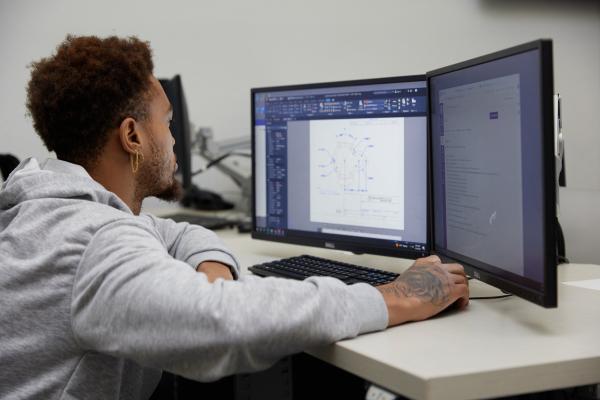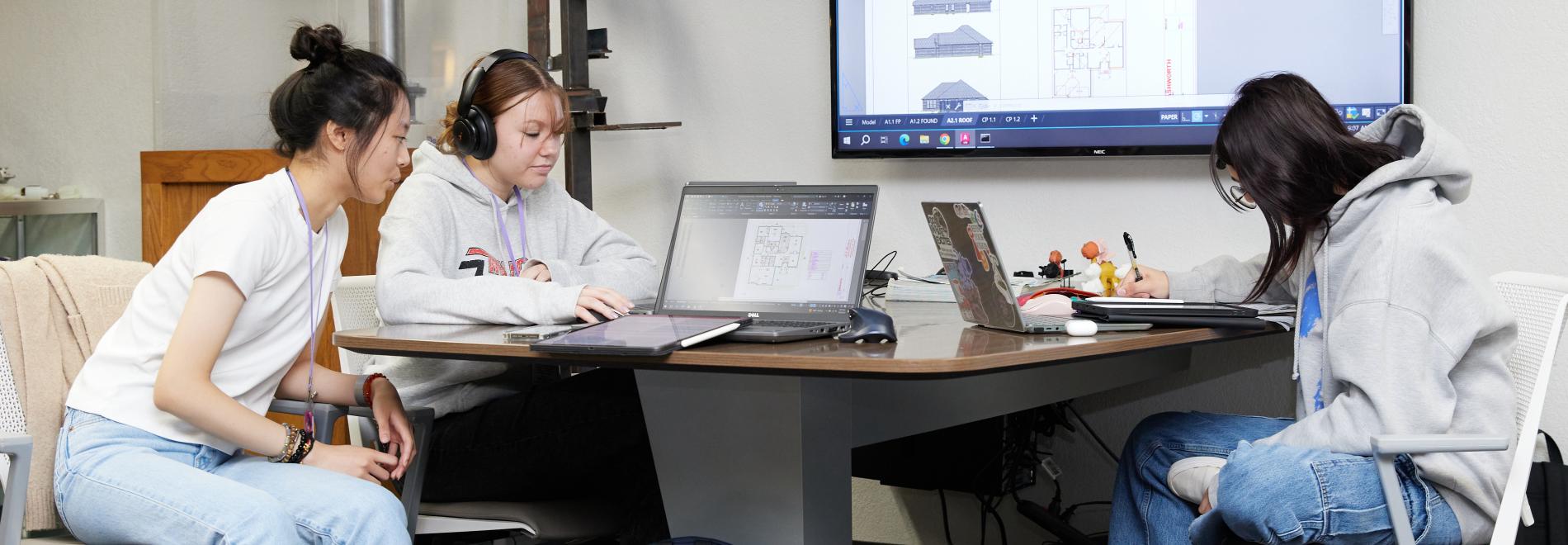“It’s kind of limitless what industry CAD deals with. Anything manmade, somebody’s getting paid to draw it and make the plans.” – Jeremiah Cook, Computer Aided Design and Drafting (CAD) Instructor on the Reno Campus
Plans are essential to the design process any time a product is created or a house is constructed. Computer Aided Design and Drafting (CAD) technicians help make ideas a reality by utilizing software to draft these plans and photorealistic renderings.
Francis Tuttle offers its CAD program for high school and adult students on the Portland and Reno Campuses, led by instructors Kyle Crowder and Jeremiah Cook, respectively. All students in the program learn established drafting standards and work extensively with AutoCAD, the widely used CAD software.
Once they are proficient in AutoCAD, students choose a discipline – architecture, civil, or mechanical – and learn the software used in that industry. Cook added that just because a student selects a discipline, it does not limit them to that area.
“One of the main things I love about CAD is that to me, it’s the perfect balance of technical and creative sides,” Cook shared. “It does take somebody with a detail-oriented and analytical mind, but you also get that creativity piece. For so many things, it seems you have to be either this or that, but CAD is a perfect blend.”
What Career Opportunities Are There with CAD?
CAD is used to draw floor plans, items that are going to be manufactured, plans for infrastructure such as roads and bridges, and more.
The skillset is needed across a variety of industries, including aerospace – a growing area in Oklahoma – architecture, oil and gas, and construction. It is even applicable in areas people may not realize, like law enforcement and the clothing and toy industries.
Cook has had students complete the CAD program because they were interested in a fashion design career, and one of his former students works at LEGO. For students planning to attend college to become an engineer or architect, CAD skills are valuable to have for completing class assignments.
“CAD is a great program in part because of how diverse it is,” Cook stated. “It doesn’t matter which direction you go to get trained. There are so many different jobs in different markets. Worldwide it doesn’t matter where you go – it’s a demand. I truly believe if you get decent with these skills, you’re set for life. It’s going to evolve of course, and I’ve seen it evolve, but it’s never going away, and that’s important.”

Why Take CAD at Francis Tuttle?
Prior to joining Francis Tuttle as an instructor 17 years ago, Cook worked primarily in the oil and gas industry. He became an instructor because he wanted to pay it forward after attending Francis Tuttle, which was “life-changing for me in a very positive way.”
The CAD program is self-paced, individualized learning, Cook takes a hands-on approach when assisting students and passing on his experience as a professional. Along with the in-person assistance, Cook is focused on forging strong relationships with students. He said Francis Tuttle has built a reputation of being known for CAD, and he takes pride in preparing students for the workforce and supporting them even after they complete the program.
While working for a company that created and operated dredge boats, CAD program student Tucker Bruce was often diagnosing problems and troubleshooting to improve the products. That experience, combined with the fact one of his best friends is a mechanical engineer, piqued his interest in the industry. His friend encouraged him to get into CAD as an entry point.
Bruce, who completes the program in May 2024, has received job offers from multiple companies. While he is still choosing his next step, he knows he wants to work in mechanical design. Along with the opportunity to problem solve, Bruce likes how a career in CAD allows for a behind-the-scenes perspective in creating a product.
“Everything that is made has to go through us, so that’s kind of the beauty of it all. We have our hands on everything,” Bruce said. “It’s not limiting. You have a myriad of options, and whatever discipline you choose, you have a lot of space you can enter. You can go as niche as you want or as broad as you want, and there’s no shortage of things to learn in this.”
What is the Future of CAD?
Like all Francis Tuttle programs, CAD uses advancements in the industry to better prepare students for potential jobs. Both Portland and Reno programs used 3D printers so students can practice creating prototypes and test their designs. This year, Cook added consumer-grade printers to this collection because he wants students to be familiar with the products many companies are buying.
The program also has a 3D scanner, which captures images of buildings that can then be modified in CAD. Access to this technology and hands-on learning helps students prepare for any job and equips them for the growing list of industries that need skilled individuals.
There is now a growing need for CAD skills in law enforcement. Through the use of scanning technology and drones, departments need CAD in their analysis of crime scenes and vehicle collisions. The CAD program is planning to offer curriculum for students who want to work toward earning their FAA drone license.
“We are trying to grow with the new technologies, and we’re evolving,” Cook said. “Old school CAD has not gone away and there is still demand for it, but we will also add these new technologies.”
